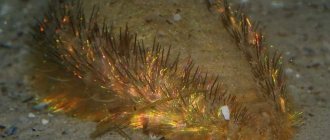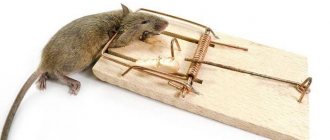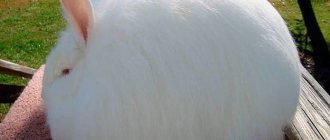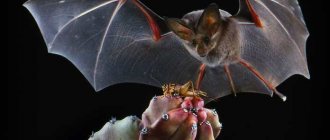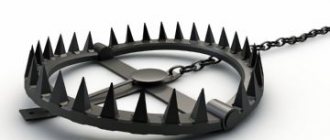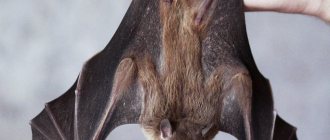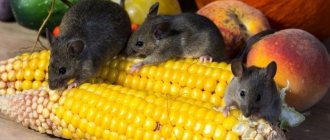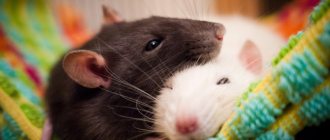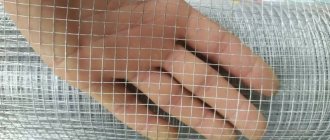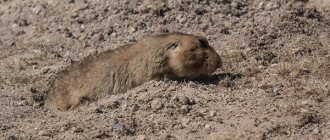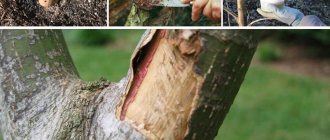Many people dream of having a pet. For some, this is a dream from childhood, for others it is the fulfillment of their child’s dreams, and for others it is an opportunity to realize unspent reserves of love.
And if for some people the lack of extra space is a problem, then anyone can have a rodent. The rodent will not require daily walking, as is necessary for man's best friends - dogs. And he won’t leave fur everywhere like cats. These cute creatures - rodents - are unpretentious in care and maintenance, do not take up much space and are very friendly towards people.
In this article, we will tell you about the types of pet rodents, as well as the pros and cons of keeping them.
Rodents
Hamsters, nutria, ground squirrels, porcupines - all these animals are united by belonging to the order of rodents, the most numerous in the class of mammals. Today there are 2606 species of these animals. Unfortunately, 49 species have become extinct over the past 5 centuries, and some are now on the verge of extinction.
The advantages of keeping them in a family with or without children
Regardless of the type of rodent, this animal can become a good friend for both a large family with children and single couples. Small rustling creatures quickly get used to people and show devotion to them.
Both children and adults will enjoy playing with the pet. And you can perfectly brighten up the time by teaching your pet simple commands or simply watching your rodent.
Responsibility of care and attention
Any pet, be it a rodent, cat, dog or ornamental bird, requires special treatment, attention and care.
Before purchasing a rodent, you need to carefully study the exact species you have chosen. Rodents need special cages, some need baths, as well as balls, houses, toys and even swings.
Pet food is selected individually, depending on the preferences of a particular species. But all rodents love seeds, cereals, fresh and dried vegetables and fruits.
Features of rodents
The name of the order Rodentia is translated from Latin as “gnaw, gnaw.” The most characteristic feature of all rodents is the enlarged incisors on both jaws. Moreover, they grow throughout their lives and are designed in such a way that they can sharpen themselves. But rodents have no fangs at all.
Most often, representatives of the order are small in size. Among them there are tiny ones, for example, the dwarf mouse, and large individuals, such as capybaras. Very often the length of the tail exceeds the length of the body (in jerboas and mice).
The shape of the limbs and body depends on the lifestyle. Gophers, which jump a lot, for example, have highly developed hind limbs. Some gliding species have a skin fold on the sides.
Rodents are mammals, and their skeleton is basically similar to the four-legged members of the class.
Diet of mice
In addition to the fact that the mouse is an omnivore, it has to constantly chew something in order to wear down its teeth, which are constantly growing. In this regard, it seems that the rodent eats ingredients that are not at all edible. Therefore, her appetite is explained by some features of her life. So:
- Mice constantly chew on hard objects to keep their teeth from reaching gigantic proportions.
- Mice digest food quickly because they are constantly on the move. During the day, the animal should eat at least 5 grams of food and drink up to 20 ml of water.
- Mice are distinguished by one characteristic feature - they taste all new objects.
The mouse is considered a predator that prefers food of plant origin. She eats worms, insects, chicks, eggs, due to which she replenishes her body with proteins. In addition, if she climbs into the nest of the chicks, she will eat them, and then she will set up her own mouse nest in the bird’s nest.
Despite this, she happily eats seeds, roots and greenery of plants. If there is not enough food for her, then she turns to vegetables, fruits and berries.
Interesting Facts! Having settled in a human home, mice eat everything - sausage, cheese, meat, lard, cookies, candy, soap, napkins, toilet paper and other non-food components. I can’t even dare say that a mouse is a predator.
Lifestyle
Most rodents are nocturnal animals, although many are also found during the day. Some animals live on their own, and some gather in entire colonies of up to one hundred individuals (naked mole rats).
You can find rodents on the ground, underground and even in the air (flying squirrels). They live on every continent except Antarctica.
Rodents mainly feed on plant foods - stems, leaves, bark, and roots of plants. Some species are carnivores. Their diet consists of various types of insects. There are also individuals with mixed nutrition.
Chipmunks
The chipmunk rodent belongs to the squirrel family. They differ from other members of the family by five dark stripes on the back. Almost all 25 species of these rodents inhabit exclusively North America. Outside its borders, only the Asian or Siberian chipmunk lives. Distributed from the taiga regions of Eurasia (including the Russian Far East, the Kamchatka Peninsula, the islands of Hokkaido and Sakhalin) to China.
These are small rodents up to 15 centimeters in length. They are densely covered with brown or red-brown fur. On the back, black stripes alternate with gray or white. The tail of chipmunks is fluffy and grows almost the size of the owner (up to 12 cm).
Chipmunks are not aggressive and can quickly get used to humans. They are excellent tree climbers, which often saves them from terrestrial predators and helps them search for food. But they arrange housing underground. The burrow can be up to three meters in length and is necessarily equipped with “pantries” for storing food.
Like hamsters, chipmunks have cheek pouches in which they carry food. They are active only during the day. During the winter, animals hibernate, curled up in a ball. In cold and rainy weather in the summer, they also wait in burrows, eating the reserves they have made.
Behavior and reproduction
Some rodents are capable of constructing a wide variety of houses; These range from holes in trees and rocks, simple burrows in nests, structures made of leaves and sticks in treetops, to complex underground tunnels, and the construction of dams on rivers and streams.
Rodents can be diurnal or nocturnal, or are sometimes active for part of the day and night. Representatives of this order can be active throughout the year, but some species experience periods of rest or deep winter hibernation.
The timing and frequency of reproduction, length of gestation, and litter size vary greatly from species to species. For example, the gray rat (Rattus norvegicus) can produce up to 22 litters at a time, and the house mouse (Mus musculus) can produce up to 14 litters annually. Population sizes can remain stable or fluctuate, and some species, especially lemmings, migrate when populations become excessively large.
Pigs
The guinea pig is one of the most common pets. They originate from South America, namely the Andes region, Colombia, Peru, Bolivia and Ecuador. These are large and shapeless animals ranging in size from 20 to 35 cm. They have no tail, a blunt muzzle and floppy ears.
Guinea pigs living in the wild have thick fur of a light brown or grayish color. Decorative species differ greatly in both colors and coat length. Rodents are peaceful and good-natured, easily tamed by humans. The first to do this were the Indians, who bred them for meat and religious rituals. European traders showed them to the rest of the world, and the animals were called “sea,” that is, overseas.
The pig family also includes maras, mokos and capybaras. They all live in South America, but bear little resemblance to their counterparts. The moko or rock pig has longer legs. She is very active and jumps several meters.
Mara is also called the Patagonian hare. It grows up to 80 cm and really looks like a scythe. The animal runs well and has strong and long hind legs. The muzzle is blunt, and the ears are slightly pointed and stick up.
Capybaras are the largest of the rodents. These include capybaras. They resemble a small ungulate rather than a rodent. These are heavy animals with a blunt muzzle, small rounded ears and an elongated body. They swim and dive well and lead a semi-aquatic lifestyle.
Jerboas
Jerboa
The group of “jerboas” is named after the jerboa family (Dipodidae). It unites small rodents (body length from 4 to 26 cm), adapted for fast movement by jumping. Their hind legs are strong and elongated, while their front legs, on the contrary, are shortened. The hind foot is very elongated and in some species reaches half the length of the body. At the end of the tail there is a characteristic tassel - a “banner”. The majority of the ears are very large and almost bare.
Interesting: The most popular domestic rodents - list, name, description, photo and video
“Jerboas” are active most often at night. They eat high-calorie plant foods (seeds, tubers, bulbs) and invertebrate animals. “Jerboas” inhabit open dry areas - steppes, semi-deserts and deserts, mainly in Central Asia, but several species live in Africa. Large-footed hamsters (Macrotarsomys) living on the island of Madagascar are very similar to jerboas.
Jerboa of the long-legged family
In Central and Southern Africa, species resembling giant jerboas are found in the family Pedetidae. These large rodents weighing up to 1-3 kg and body length up to 48 cm inhabit desert and semi-desert plains. Long-legged animals can be considered champions among rodents in long jumping. A frightened animal immediately recoils 2-3 meters, and according to some reports - 6-9 meters.
Mice and rats
Mice or Muridae are a huge family that includes about 400 species and several hundred genera. This includes the genus of rats. Mice are usually small, up to 10-15 centimeters in size. Rats are larger and can grow up to 50 centimeters in length.
These are nocturnal omnivores. Basically, they lead a semi-terrestrial lifestyle: they hunt on the surface and build burrows underground. Animals prefer subtropical and tropical areas, but live almost everywhere. They were brought by humans even to remote islands.
Mice have smoother and more rounded features and larger ears. Rats, on the contrary, have small ears, an elongated silhouette, and a pointed muzzle. They are larger and more aggressive than their counterparts. Mice are very timid and try to avoid unnecessary encounters; rats do not always run away and are capable of attacking the enemy.
All members of the family have calluses on their paws, which help them move along trees and other surfaces. The tails may be almost naked (most rats, grass mice, yellow-throated mice) or covered with hair (black-tailed rats).
The animals themselves are also covered with thick hair. Its color is usually monochromatic or with a small splash of other shades. The color of the animals is predominantly grayish, black, brown or brown. Field mice and baby mice have reddish or yellowish fur.
Hamsters
Hamster
Another group of terrestrial rodents, the “hamsters”, includes short-tailed, blunt-faced, small omnivorous animals. All of them are inhabitants of flat or foothill steppes and deserts, are sedentary, live alone, and lead a burrowing or semi-burrowing nocturnal lifestyle. In winter, “hamsters” feed on supplies made in the fall, sometimes falling into shallow hibernation. Typical representatives of this life form - the Western Asian, or Syrian, hamster and the Djungarian hamster - are often kept in captivity.
Prairie and Chinese dogs
A rodent that deserves a separate story. Several years ago it literally amazed Russian gardeners. A new animal suddenly appeared on farmland and cottages, quickly destroying crops. Without understanding its origin at all, summer residents quickly dubbed the rodent a Chinese dog.
It's actually a water vole. The animal belongs to the hamster family. It grows 15-20 cm long, lives near rivers and other bodies of water, destroying fruit, cereals and vegetable crops nearby. The water vole is considered one of the main pests of the economy.
She previously lived in the region of Siberia, Kazakhstan, the Lower Volga region and the North Caucasus. But the rodent received such a strong reaction and a new name relatively recently. By the way, among rodents there are other dogs – prairie dogs. They belong to the squirrel family and live in North America. They prefer arid areas with low bushes.
Prairie dogs are quite large. They reach 35 centimeters in length and weigh about 1.5 kg. In appearance, the animals resemble marmots; they also stand on their hind legs, stretching their bodies upward and pressing their front paws to their chest. They have light fur of gray-brown shades. The tail is white on all except black-tailed dogs and Mexican dogs.
Voles: varieties and harm
The vole has similar characteristics to other mice. Its peculiarity is a dark stripe on the back, slight differences in the muzzle, and a shorter tail. Classification of rodent pest species with names:
- Common vole. The body is about 9-12 cm long and has a very short tail (4 cm). The fur is gray. The rodent reproduces intensively. Young mice reach sexual maturity very quickly. Based on family connections, colonies arise, for which individuals build an extensive network of tunnels with storerooms and other compartments. The rodent feeds exclusively on plants and grain.
Vole
- Arable vole. The length of the body is about 11 cm, the tail is about 4 cm. It has looser and longer fur than that of the common vole. Color - brown. Rodent burrows should be looked for in dense grass. He loves plants and can covet the succulent bark of young trees.
- Red vole. Length - up to 11 cm, tail - up to 6 cm. It has a characteristic red coat. It can live both underground and in some shelter on the surface. The rodent is not very fertile for mice. Eats bark, plants and grains, insects and invertebrates.
